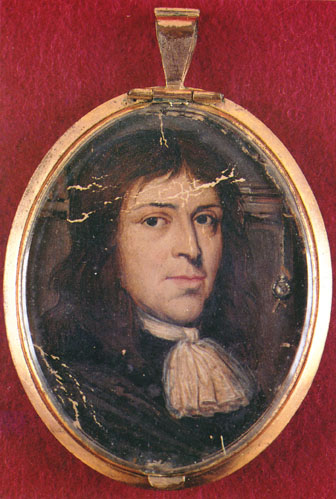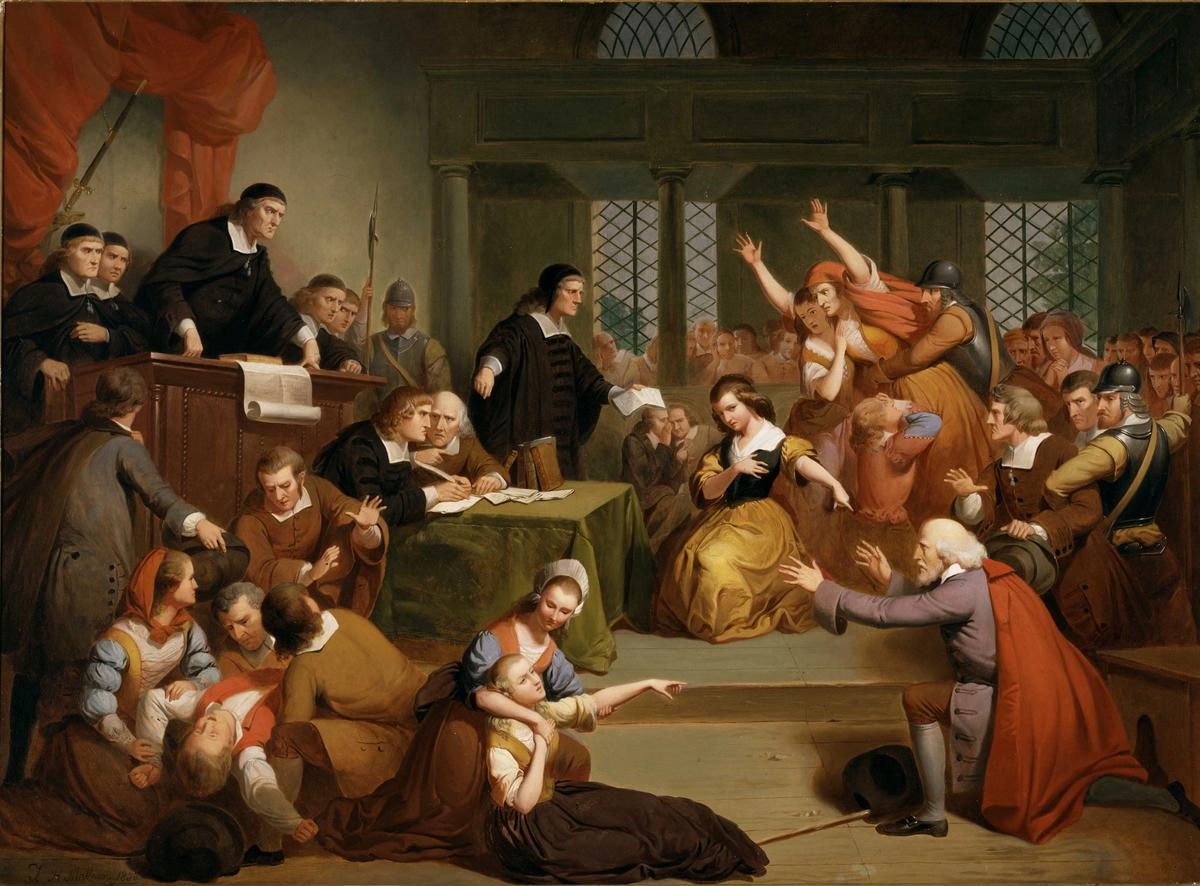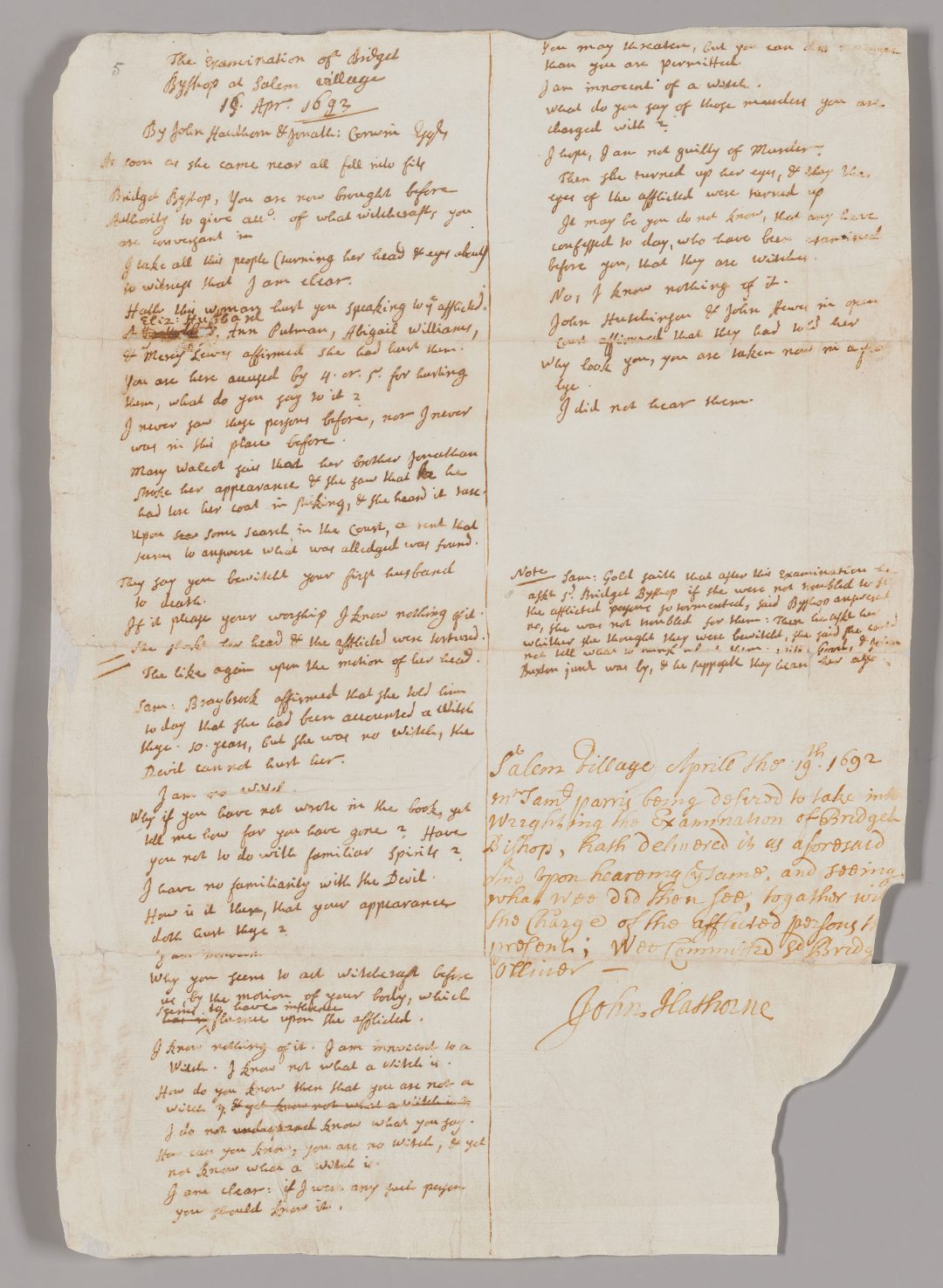
Salem Witchcraft Papers
The Salem Witch Trials were a series of court hearings and prosecutions of people who were accused of committing witchcraft in Colonial Massachusetts from early 1692 to mid-1693. [1]The hysteria began when two young girls in the household of Reverend Samuel Parris, Salem Village’s first ordained minister, began having “fits.” They were screaming, making odd sounds, throwing objects, and complaining of the pain of pinching. A local doctor claimed these fits were a product of the supernatural. The girls ultimately accused three local women: Tibuta, an enslaved woman working in the Parris’ home, a homeless beggar, and an impoverished woman of afflicting them.

Reverend Samuel Parris
The three women were interrogated for several days. While the other two women were adamant that they were innocent, Tibuta confessed to witchcraft and claimed the women were involved as well. After this confession, more young girls began accusing more men and women of the town who were then arrested and questioned. [2]According to Benjamin C. Ray, author of “‘The Salem Witch Mania’: Recent Scholarship and American History Textbooks,” “Thereafter, accusations of witchcraft were no longer understood merely to be about matters of neighbor-on-neighbor malice or torment but were seen as part of a larger Satanic plan to destroy the village church and eventually all the churches in New England.” What followed was a series of mass hysteria that ran through the town. People could accuse anyone of practicing witchcraft, and the claims were taken very seriously. [3]In “Chapter 6: The Belief in Evil and Its Redefinition during the Salem Witch Trials,” author Stefanie Schnitzer Mills describes, “A special court was established and within three sessions, 19 persons were sentenced to death. At the height of the trials, some 150 people were accused of witchcraft and awaited trials.”

Bridget Bishop
The first woman convicted by the court was a woman named Bridget Bishop. The historical source chosen is a transcription of the court records from Bishop’s hearing. This transcript is included in a series of legal documents titled the “Salem Witch Trials Documentary Archive and Transcription Project.” The edition includes records dating from January 2nd, 1692 to March 28th, 1750 that were released to the public. The historical source is titled “SWP No. 013: Bridget Bishop Executed, June 10, 1692.” The source includes two different recordings of examination of Bishop, indictments of Bishop for afflicting four different women, two depositions, nine testimonies against her, a physical examination, and a warrant for her execution. These sources, as all court documents are, were recorded to give a detailed, word-for-word account of the trial to be reviewed or studied later. Bridget is asked a series of questions and remains adamant that she is “no witch,” and has “no familiarity with the devil.” It is noted in the document that just by Bishop shaking her head, “the afflicted were tortured.” This could be dramatized, as it is doubtful that just by the shaking of her head, the afflicted were that affected. This could possibly be the person who recorded the exchange exaggerating in order to make Bishop’s guilt more promising.
In the testimonies, many describe Bishop breaking into their homes late at night and inflicting violence on them. These instances allegedly dated back to 1678. It is unknown why none of these people came forward about Bridget until the mass hysteria happened fourteen years later. It seems as if they were recalling disturbing occurrences or crimes that they had experienced and decided to blame it on Bridget Bishop because she had already been accused by someone else. According to the records, a lot of these people were unable to name the woman who they’d seen for all those years, but suddenly once Bishop was going to trial, they could now identify her. According to the warrant for her execution, it was directed that Bishop be hung on the 10th day of June between the hours of 8am and 12pm. This was carried out, and Bridget Bishop became the first person executed for witchcraft during the Salem Witch Trials.

Depiction of one of the trials.
In a journal article titled [4]“Examination of the Records of the Salem Witch Trials” by Margo Burns and Bernard Rosenthal, it is stated, “The discovery and printing of these identities open up worlds, enabling scholars now, for example, to investigate the patterns of participation of various individuals in the proceedings, to explicate the actual procedures used, and to articulate the sequence and concurrence of events with a degree of precision previously impossible.” The publishing of these documents gives us new insight into how the trials were carried out, what questions were asked, and what was allowed to be said. It shows us how much the legal system has improved since the late 17th century and how little evidence was needed to convict someone of a crime. This historical source is one of many examples of how American History was very flawed, and how many innocent lives were lost due to unnecessary turmoil and unrest.
All Documents on Bridget Bishop: https://salem.lib.virginia.edu/n13.html
[1] Blumberg, Jess. “A Brief History of the Salem Witch Trials.” Smithsonian.Com, 23 Oct. 2007, www.smithsonianmag.com/history/a-brief-history-of-the-salem-witch-trials-175162489/.
[2] Ray, Benjamin C. “‘The Salem Witch Mania’: Recent Scholarship and American History Textbooks.” Journal of the American Academy of Religion 78, no. 1 (March 1, 2010): 40–64. https://eds.s.ebscohost.com/eds/pdfviewer/pdfviewer?vid=5&sid=d45e8de4-f9a2-479d-8873-543decac9fcd%40redis
[3] Mills, Stefanie Schnitzer. “CHAPTER 6: The Belief in Evil and Its Redefinition during the Salem Witch Trials.” At the Interface / Probing the Boundaries 124 (June 3, 2019): 126–42. https://eds.s.ebscohost.com/eds/pdfviewer/pdfviewer?vid=3&sid=36928a98-8ac4-42f0-8c04-cf0dc4b0dedf%40redis
[4] Burns, Margo, and Bernard Rosenthal. “Examination of the Records of the Salem Witch Trials.” The William and Mary Quarterly, vol. 65, no. 3, 2008, pp. 401–22. JSTOR, https://www-jstor-org.ezproxy.shu.edu/stable/25096805?seq=1
